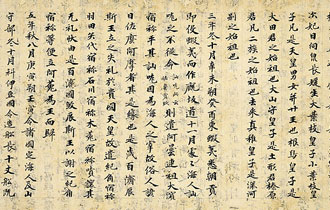Pages |
After 1600, however, when Japan became peaceful under the Tokugawa regime, interest in classical studies began to develop in new and fresh ways. Although the Tokugawa Shoguns largely cut their prior ties with Europe, they did maintain rather close ties with China though the port of Nagasaki, where books, paintings, even musical instruments could be located and purchased. These opportunities helped stimulate an interest in the Chinese arts that continued to grow and develop steadily for some two hundred years. Indeed, there developed in Japan what we might term as a "cult of the literati," no doubt a direct influence of the qin's social position in China. Many Japanese artists and intellectuals took as their model the figure of the Chinese gentleman who revered contemplation and an indulgence in the arts, whose status as an amateur might give his artistic works a depth and beauty not available to "mere" professional artists or musicians. Indeed, one of the most beautiful and admired forms of painting in the period is referred to as nanga or bunjinga. The term nanga means "Southern-style painting," a reference to the style of literati art created in the Southern Sung period (c.1120-1279CE) in China; bunjinga means literally "painting of the literati."
It was through such contacts that the qin re-emerged as an important instrument for sophisticated music lovers. Qin handbooks for the instrument were newly imported from Nagasaki, and there were teachers of the instrument in Edo, possibly elsewhere. Many learned to play the instrument, but perhaps the most distinguished musician of the period, and a literati figure in every sense of the word, was Uragami Gyokudō (1745-1820). His reputation as a poet, and painter was high, but he was primarily known as a musician, and his performances on the qin were legendary. His life and work is emblematic of the importance of Chinese musical and artistic culture in Tokugawa Japan.
In many of his poems, often written in classical Chinese, Gyokudō created a persona for himself, that of a scholar-musician.
For ten thousand sen
I bought a old qin,
For one thousand sen
I bought old books.
At dawn,
I play by the faint light of my window,
At dusk,
I read by the lamplight in the cold.
Gyokudō not only performed the classic scores for the qin, but he wrote music for the instrument himself. The first edition of his music appeared in 1789, and it was reprinted two years later. Accompanying the musical notations is an explanation of how he adapted ancient Japanese melodies for performance on this most Chinese of instruments. As one of his pupils wrote, "Gyokudō's fame is unsurpassed. He is versed in the four talents of poetry, calligraphy, painting, and qin music, the last being his specialty."
Gyokudō's music performances were considered so special that those friends who particularly appreciated his musical talents, found their way to him.
Pages |











